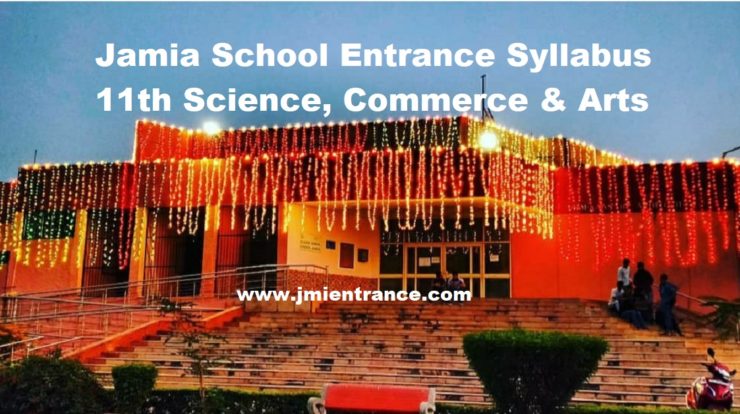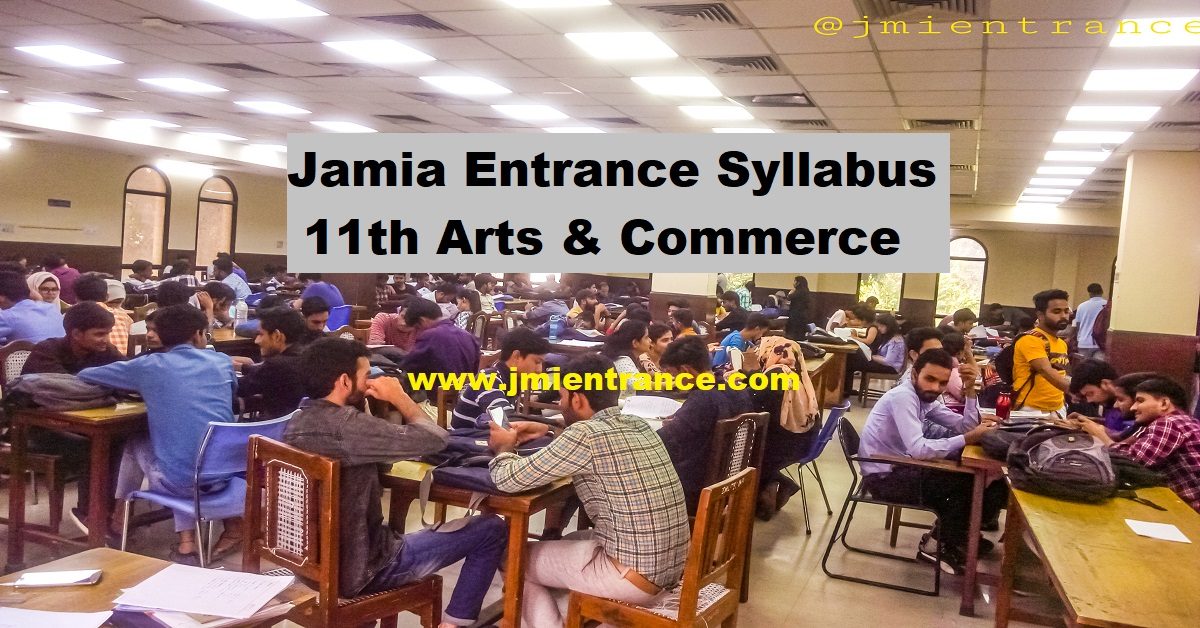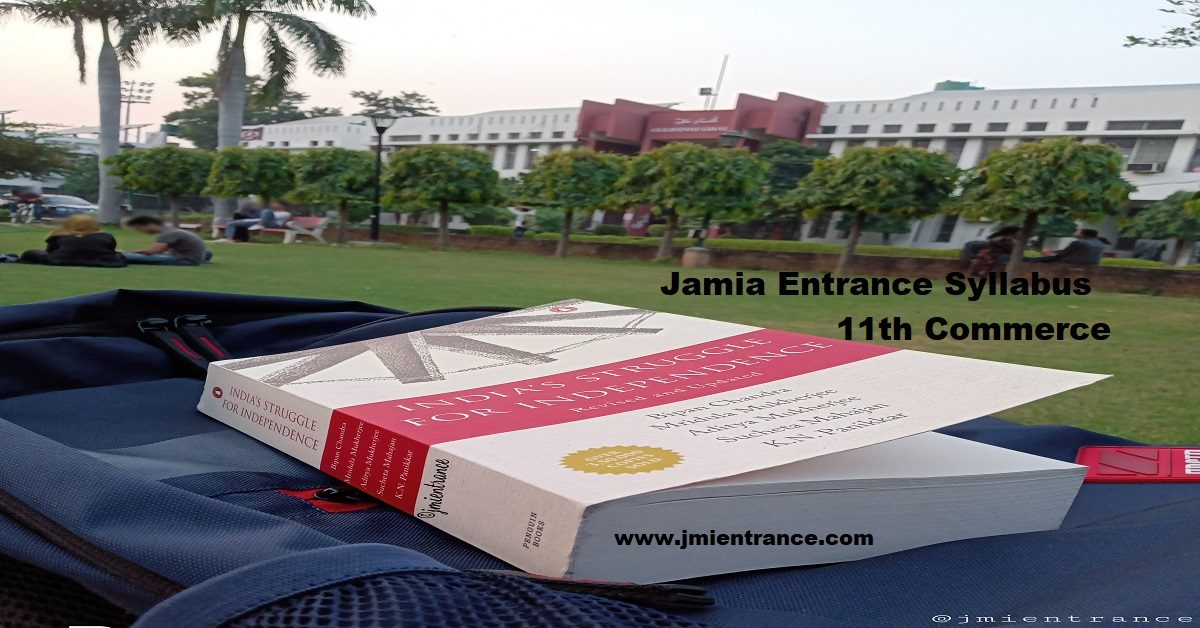
In this article we will provide detailed syllabus for Jamia school class 11th. The syllabus is prepared by JMIEntrance team. So that students can start preparation for their entrance examination, specially 11th Science, Commerce & Arts.
Subject: English
(This Syllabus is for all the three stream Science, Arts and Commerce)
- Kinds of Sentences: Assertive, Imperative, Interrogative, Exclamatory and Optative.
- Tenses: All Tenses, Formation and Usage.
- Narration: Assertive, Imperative and Interrogative, simple sentences only.
- Questions based on unseen passage.
Syllabus for Admission Test to Class 11 in Science Stream
1. Chemistry
Chemical Substances – Nature and Behaviour
Acids, Bases and Salt: Definition in terms of furnishing of H+ and OH- ions, General properties, examples and uses, concept of PH scale, (Definition related to logarithm not required) importance of PH in everyday life: Preparation and uses of sodium Hydroxide, Bleaching powder, baking soda, washing soda and Plaster of Paris.
Chemical Reactions: Chemical equation, Balanced Chemical equation, Implications of balanced chemical equations, types of chemical reaction: combination, decomposition, displacement, double displacement, precipitation, neutralization, oxidation and reduction in terms of gain and loss of oxygen and hydrogen.
Metals and Non-metals: General properties of metal and non-metals, reactivity series, formation and properties of ionic compounds, basic metallurgical processes, corrosion and its prevention.
Carbon Compounds: Covalent bonding in carbon compounds. Versatile nature of carbon, Homologous Series, Nomenclature of carbon compounds, functional groups, (Halogens, Alcohols, Ketones, Aldehydes, Alkanes and Alkynes) difference between saturated hydro carbons and unsaturated hydro carbons, Chemical properties of carbon compounds (combustion, Oxidation, Addition and Substitution) ethanol and ethanoic acid (only properties and uses), Soap and detergent.
Periodic Classification of Elements: Need for classification, Modern periodic table, gradation in properties, Valency, Atomic Number, Metallic and non-metallic properties.
2. Biology
World of Living
Life process: “Living Being”: Basic concept of nutrition, respiration, transport and excretion in plants and animals.
Control and Co-ordination in Animals and Plants: Tropic movements in plants, Introduction in plants hormones, Control and co-ordination in animals, Nervous system, voluntary, involuntary and reflex action, Chemical co-ordination, animal hormones.
Reproduction: Reproduction in animals and plants (asexual and sexual). Reproductive Health Need and method of family planning, Safe sex vs HIV/AIDS, Child bearing and women’s health.
Heredity and Evolution: Heredity; Mendels Contributions – Laws of Inheritance of Traits, Sex Determination, Brief introduction; Basic concept of evolution.
3. Physics
Effects of Current: Electric Current, Potential difference and electric current, Ohm’s law; Resistance, Resistivity Factor on which the resistance of a conductor depends. Series combination of resistors, parallel combination of resistors and its application in daily life. Heating effect of electric Current and its application in daily life, Electric power, Interrelation between P, V, I and R.
Magnetic Effects of Current: Magnetic field, field lines, field due to a current carrying wire, field due to current carrying coil or solenoid; Force on current carrying conductor, Fleming’s Left Hand Rule. Electromagnetic induction, Induced potential difference, Induced current, Fleming’s
Right Hand Rule, Direct current, Alternating current; Frequency of AC, Advantage of AC over DC, Domestic electric circuits.
Natural Phenomena: Reflection of light at curved surfaces, Images formed by spherical mirrors, centre of curvature, principal axis, principal focus, focus length, mirror formula (Derivation not required), Magnification.
Refraction, Laws of refraction, refractive index: Refraction of light by spherical lens, Images formed by spherical lenses. Lens formula
(Derivation not required). Magnification. Power of a lens; Functioning of a lens in human eye, Defects of vision and their correction, application of spherical mirrors and lenses. Refraction of light through a prism, dispersion of light scattering of light, applications in daily life.
3. Environment
Conservation of Natural Resources: Conservation of natural resources, Management of natural resources; conservation and judicious
use of natural resources, Forest and wild life, Coal and Petroleum conservation. Examples of people’s participation for conservation of natural resources.
The Regional Environment: Big Dams: advantages and limitation; alternatives (If any). Rain water harvesting, Sustainability of natural resources.
Sources of Energy: Different forms of energy, conventional and non-conventional sources of energy, Fossil fuels, Solar energy, Biogas, wind, water and tidal energy, Nuclear energy, Renewable versus non-renewable sources of energy.
Our Environment: Eco–system, Environment problems, waste production and their management, biodegradable and non – biodegradable substances, ozone depletion.
4. Mathematics
Number Systems Real:
Numbers:
Euclid’s division lemma, Fundamental Theorem of Arithmetic – examples, rational and irrational numbers, decimal expansions of rational numbers (terminating / non – terminating recurring numbers).
Algebra:
Polynomials:
Zeroes of a polynomial. Relationship between zeroes and coefficients of a polynomial with particular reference to quadratic polynomials. Simple problems on division algorithm for polynomials reference to quadratic polynomials. Simple problems on division algorithm for polynomials with real coefficients. Awareness of geometrical representation of polynomials.
Pair of Linear Equations in Two Variables
Pair of linear equations in two variables. Problems on geometrical representation of different possibilities of solutions. Algebraic condition for number of solutions. Solution of pair of linear equations in two variables algebraically – by substitution, by elimination and by cross multiplication. Simple problems must be included. Simple problems on equation reducible to linear equation shall be included.
Quadric Equation
Standard form of a quadratic equation 2 + + = 0, ( ≠ 0). Solution of the Quadratic equations (only real roots) by factorization, and by completing the square method and using quadratic formula, Relationship between discriminant and nature of roots.
Arithmetic Progression
A.P Standard results of A.P. i.e. nth term and sum of first n terms.
Trigonometry
Introduction to Trigonometry
Trigonometric ratios of an acute angle of a right-angled triangle, trigonometric ratios of specific angles i.e. 00, 300, 450, 600 and 900. Relationship between the trigonometric ratios.
Trigonometric Identities
Applications of the identity sin2 θ + cos2 θ = 1, 1 + tan2A=sec2A, 1+tan2A=sec2A, 1+cot2A=cosec2A). Trigonometric ratios of complementary angles.
Height and Distances
Simple problems on height and distance. Problems shall not involve more than two right Angles triangles. Angle of elevation/depression shall be only 300, 450, 600.
Coordinate Geometry
Concept of coordination geometry including graphs of linear equations. Distance between two points and section formula (internal). Area of a triangle.
Geometry
Triangles
Similar triangles and problems based on:
If a line is drawn parallel to one side of a triangle to interest the other two sides in distinct points, the other two sides are divided in the same ratio. (Thale’s Theorem) If a line divides two sides of a triangle in the same ratio, the line is parallel to the third side. (Converse of Thale’s Theorem) If in two triangles the corresponding angles are equal, their corresponding sides are proportional and the triangles are similar. (AAA similarity) If the corresponding sides of the triangles are proportional, their corresponding angles are equal and the two triangles are similar. (SSS similarity) If one angle of a triangle is equal to one angle of another triangle and the sides including these angles are proportional, the two triangles are similar. (SAS similarity) If a perpendicular is drawn from the vertex of the right angle of a right triangle to the hypotenuse, the triangle on each side of the perpendicular are similar to the whole triangle and to each other.
The ratio of the areas of two similar triangles is equal to the ratio of the squares of their corresponding sides.
In a right triangle, the Square on the hypotenuse is equal to the sum of the squares of the other two sides. (Pythagoras Theorem) In a triangle, if the square on one side is equal to sum of the square of the other two sides, the
angles opposite to the first side is a right angle. (Converse of Pythagoras Theorem)
Circles
Problems based on:
Equal chords subtends equal angles at the centre If angles subtended by chords of circle at the centre are equal then the chords are equal.
The perpendicular from the centre of the circle to the chord bisects the chord. If the line drawn through the centre of a circle to bisect the chord is perpendicular to the chord. Equal chords of a circle are equidistant from the centre.
The chords equidistant from the centre of a circle are equal in length.
The angle subtended by an arc at the centre is double the angle subtended by it at any point on remaining part of the circle.
Angles in the same segment of a circle are equal.
The sum of either pair of opposite angles of a cyclic quadrilateral is 1800. Tangents to a circle at a point on the circle Tangents to a circle from a point outside it.
Mensuration
Areas related to circles: Area of sector and segment of a circle. Problems based on areas and perimeter/ circumference of the above said plane figures. (In calculating area of segment of a circle, problems should be restricted to central angle of 60°, 90°, & 120° only. Plane figures involving triangles, simple quadrilaterals and circle should be taken.
Surface Areas and Volumes
Problems on finding surface areas and volumes of combination of any two of the following: cubes, cuboids, spheres, hemispheres and right circular cylinders/ cones. Frustum of a cone. Problems based on conversion of solid from one shape to another (Problems with combination of not more than two different solids be taken).
Statistics and Probability
Statistics
Problems based on Mean, median and mode of a data.
Probability
Probability as given in Class IX, X. Simple problems on single events, not using set notation.

Syllabus for Admission Test to Class 11 in Arts & Commerce Stream
1. History:
Nationalism in Europe:
(a) The growth of Nationalism in Europe after the 1830s
( b ) The ideas of Giuseppe Mazzini etc.
(c) General characteristics of the movements in Poland, Hungry, Italy, Germany and Greece.
Nationalist Movement in Indo-China:
(a) French colonialism in Indo-China. (b) Phases of struggle against the French.
(c) The ideas of Phan Dinh Phung (or poet Ngyuyen Dinh Chieu), Phan Boi Chau, NguenAc Quoc,
(d) The Second World War and the liberation struggles,
(e) America and the second Indo-China war.
Nationalism in India: Non-Cooperation and Civil Disobedience Movements:
(a) First World War, Khilafat and Non-Cooperation
(b) Salt Satyagrah.
(c) Movements of peasants, workers, tribals. (d) Activities of different political groups.
Industrialization 1850s – 1950:
(a) Contrast between the form of industrialization in Britian and India,
(b) Relationship between handicraft and industrial production, formal and informal sectors.
(c) Livelihood of workers, case studies: Britian and India.
Urbanization and Urban Lives:
( a ) Patterns of urbanization,
( b ) Migration and the growth of towns,
( c ) Social change and urban life,
(d) Merchants, middle classes, workers and urban poor; Case studies of London and Bombay in the 19th and 20th centuries.
Trade and Globalization:
( a ) Expansion and integration of the world market in the 19th and early 20th century.
(b) Trade and economy between the two World Wars
(c) Shift after the 1950s
(d) Implications of Globalization for livelihood patters; Case study: The Post – Second World War International Economic order, 1945 to 1960s.
Print Culture and Nationalism
( a ) The history of print in Europe
(b) The growth of press in 19th century India,
(c) Relationship between print culture, public debate and politics.
History of the Novel:
(a) Emergence of the novel as a genre in the West,
(b) The relationship between the novel and changes in modern society,
(c) Early novels in 19th century India, (d) A study of two or three major writers.
2. Geography
Resources: Types- Natural and Human: Need for Resource planning.
Natural Resources: Land as a resource, soil types and distribution: Changing land use pattern; Land degradation and conservation measures
Forest and Wildlife Resources: Types and distribution, depletion of flora and fauna: Conversation and protection of forest and wild life.
Agriculture: Types of farming, major crops, cropping patterns, technological and institutional reforms: Their impact; Contribution of agriculture to national economy, employment and output.
Water Resources: Sources, distribution, utilization, multi-purpose projects, water scarcity, need for conservation and management, rain water harvesting (One case study to be introduced).
Mineral Resources: Types of minerals, distribution, use and economic importance of minerals, conservation.
Power Resources: Types of power resources, conventional and non- conventional, distribution and utilization and conservation.
Manufacturing Industries: Types, spatial distribution, contribution of industries to national economy, industrial pollution and degradation of environment, measures to control degradation. (One case study to be introduced) Transport, Communication and Trade.
3. Civics (Political Science)
Power Sharing Mechanism in Democracy
Why and how is power shared in democracies?; How has federal division of power in India helped national unity?; To what extent has decentralization achieved this objective?; How does democracy accommodate different social groups?
Working of Democracy
Are divisions inherent to the working of democracy?; What has been the effect of caste on politics and of politics on caste?; How has the gender division shaped politics?; How do communal divisions affect democracy?
Competition and Contestations in Democracy
How do struggles shape democracy in favour of ordinary people?; What role do political parties play in competition and contestation?; Which are the major national and regional parties in India?; Why have social movements come to occupy large role in politics?
Outcomes of Democracy
Can or should democracy be judged by its outcome?; What outcome can one reasonably expect of democracies?; Does democracy in India meet these expectations?; Has democracy led to development, security and dignity for the people?; What sustains democracy in India?
Challenges to Democracy
Is the idea of democracy shrinking?; What is the idea of democracy in India?; How can democracy be reformed and deepened?; What role can an ordinary citizen play in deepening democracy?
4. Economics
The Story of Development: The traditional notion of development; National Income and Percapita income; Growth of NI – critical appraisal of existing development indicators (PCI, IMR, SR and other income and health indicators); The need for health and educational development: Human development indicators (in simple and brief as a holistic measure of development). The approach to this theme: use case study of three states (Kerala, Punjab and Bihar) or take a few countries (India, China, Sri Lanka and one developed country)
The Role of Service Sector in Indian Economy: What is service sector (through examples); Importance of Service Sector in generating employment and income to the nation (with the help of few case studies); Growth of Service Sector in India: India as a major service provider
to the world; The need for public investment: the role of important infrastructure, education and health.
Money and Financial System: Role of money in an economy; Historical Origin; Formal and Informal Financial Institutions for saving and credit, general introduction; Select one formal institution such as nationalized/commercial bank and a few informal institutions; local money
lenders, landlords, self help groups, chit fund and private finance companies.
Globalization and the Indian Economy: What is Globalization (through some simple examples)?; How is India being globalized and Why?; Development strategy prior to 1991: state control of industries (textile goods as an example of elaboration); Economic reforms since 1991: strategies adopted in reform measures (easing of capital flows, migration, investment flows); Political impact of globalization.
Consumer Awareness: How is consumer exploited (one or two simple case studies)?; Factors causing exploitation of consumers; Rise of consumer awareness and consumer rights; Role of government in consumer protection.

For Commerce Candidates Only
Elementary Mathematics
Square and Square roots of numbers including numbers in decimal forms, Cubes and cube roots of numbers.
Exponents and Radicals. Positive as well as negative rational numbers as exponents.
Laws of exponents for rational numbers.
Algebraic expressions, multiplication and division of algebraic expressions. Equation, Solution of an algebraic equation in one variable, application of equations to solve problems, simple interest, profit and loss.
| Entrance Question Paper (JMI) | Download Link |
|---|---|
| 11th Science Combined Papers | Download |
| 11th Commerce Combined Papers | Download |
| 11th Arts Combined Papers | Download |

Ask Your Queries below: